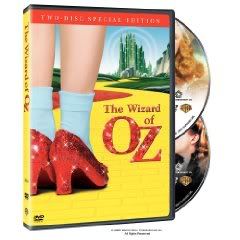There's no need to discuss "The Wizard of Oz" itself, a classic among classics (though I'll have something to say about its "philosophy" later on). You probably want to know whether the UltraResolution transfer justifies the purchase. It does. Oh, yes it does. "The Wizard of Oz" has always looked good, one of the better Technicolor films. Unlike "Gone With the Wind", which was generally dark and desaturated, and which UltraResolution greatly improved, I didn't expect much enhancement for "Oz". Was I ever wrong. I stared with my jaw hanging open. "Oz" is the best UltraResolution transfer by far -- and the others were not exactly chopped liver. The improvement in detail and sharpness is startling, especially as the original prints did not seem obviously lacking in either. Even more amazing is the expansion of the tonal scale. Dark scenes (particularly those in the forest and outside the "witches" castle) are now filled with rich detail. Have you ever noticed how beautiful the Winkies' red, white, and gray uniforms are? I hadn't -- until now. These enhancements combine produce the biggest improvement of all -- a major revelation of _texture_. The "feltiness" of many costumes is obvious. The burlap of the Scarecrow's face is now plainly visible, particularly in the close-up where he misstates the Pythagorean Theorem. And the Lion's costume is a thick pile of fur you want to reach out and stroke. You can see every last strand of hair. I'm exaggerating only slightly when I say the improvements of this UltraResolution transfer are not much less than those from cleaning the Sistine Chapel's frescos. It's as if layers of murk and grime -- that you never even knew were there! -- have been stripped away. Until you view it, you cannot imagine what this film (that is, the original camera negatives) _really_ looks like. It's a shame the people who created "Oz" never got to see it this way. The image quality is so high that I often felt as if I were looking through a window at live performers. (Well, almost.) No matter what versions you already have, you won't be disappointed with this one. I watched it twice in two days, and I might even view it a third time tonight. My only quibble is that several matte paintings do not blend properly, because the hues at the join lines do not match those of the scene. This could have been fixed; I suspect it seemed too much work for a small improvement. (A friend suggested that these sorts of things are left in because videophiles enjoy finding them.) As to the differences between the two- and three-disk sets... The latter includes a packet of original programs and promotional material of the sort we haven't seen in 40 years ago. (Remember the 50-cent deluxe programs for road-show films?) There's also a set of 10 reproductions of Kodachrome publicity photographs. For this viewer, these extras alone justify the higher price. The third disk will be of most interest to lovers of all things Oz. It includes a handsomely produced biography of L. Frank Baum (interesting enough that you might want to watch it more than once), plus all the silent Oz films and a Technicolor Oz cartoon. The existence of these is well-known to anyone familiar with the history of Oz productions, but they've never appeared (as far as I know) in any home-video format. The films are problematic. The two from Baum's production company are the best -- they have style, charm, and imagination. The others are cheesy ripoffs that bear little relation to the original book. The Larry Semon -- a once wildly-popular but now virtually forgotten cartoonist and comic * -- version is especially obnoxious, as it is little more than a vehicle for Semon's brand of physical comedy. The Baum estate is at least partly to blame -- _any_ movie version must have seemed more attractive than none, especially as the technology to make a convincing version of "Oz" would not exist for another 15 years. The film's opening titles praise the book's "kindly philosophy", which seems to be either "You already have everything you need to be happy", or "The answer to your problems lies within yourself". These are not so much "kindly" as reflections of the hard-nosed "All your problems are your own fault" and "If you're not a success, it's because you're lazy" homilies that grew out of the great opportunity for personal development and material success this country offered. I believe L. Frank Baum had something a bit different in mind. "The Wizard of Oz" is a fairy tale in which magic has no bearing on the issues at the center of the story. I believe Baum wanted to discourage children from fantasizing that magic could be a solution to one's problems. The four principals make a grueling journey to the Emerald City, then find the wizard is a humbug. (What a shame the blander "fake", "fraud", or "phony" have replaced that delightful word.) He posesses no magic to supply wit, love, or grit, which the Scarecrow, Tin Woodman, and Cowardly Lion have demonstrated they already have. Baum's "moral" is simple -- Love, wisdom, and courage are what we need to get through life. No one can _give_ them to us, because we _already_ possess them, and all we need to do is express them. "Is that right?"
